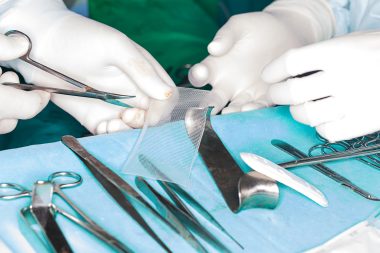Mom Watched Her Life ‘Disappear’ After Pelvic Mesh Complications
Donna Miser considered herself a driven person — active and healthy. As a mom, wife, grandmother and employee, she lived her life to the fullest. She described loving her job, breaking records in her department and working 40 to 50 hours a week.
That all changed when she had a transvaginal mesh sling implanted. Transvaginal mesh slings, a type of bladder sling often made from synthetic mesh, are surgically implanted through the vagina to support the urethra or bladder neck to treat incontinence. Before 2019, transvaginal mesh was also used to treat pelvic organ prolapse, but the FDA has since banned its use for that purpose.
After receiving the mesh sling, Miser started suffering severe complications such as pain during sex, bloody discharge and a knife-like pain in her vagina.
She said she felt like a completely different person, watching her life disappear. After her first mesh removal surgery, she gradually worked up to being able to move around for 15 minutes before she was down again.
“One minute I was happy at work, healthy and physically fit. I mean, for being 58, I was 30. Now, I’m 80, and it drives me nuts,” Miser told Drugwatch.
She’s now looking to file a transvaginal mesh lawsuit. In an interview with Drugwatch, Miser shared her painful journey through mesh complications, hoping to help spread awareness and prevent others from suffering what she went through.
The Bladder Sling Surgery That Started It All
After a hysterectomy, Miser had a bladder prolapse, meaning her bladder moved down from its normal position, and she began experiencing some urinary incontinence.
“Every time I went and jumped on the trampoline, I’d pee myself. My kids thought it was just the funniest thing in the whole world,” Miser recalled.
Her doctor said he could implant a bladder sling to take care of the incontinence associated with her bladder prolapse. Miser went through with the procedure on her doctor’s recommendation. She was never made aware of the risks.
At first, there weren’t any complications. But a few years later, she suddenly developed excruciating pain during intercourse. It was so intense that it made her instantly vomit.
“Eventually, I just quit ‘trying’ to have sex. No sex meant no pain,” she said.
At that point, she had not drawn a connection between her pain and the mesh.
Mesh Complications Misdiagnosed As a UTI
One day at work, Miser felt a pain in her abdomen but dismissed it as just pain from making a wrong movement. By lunchtime, the pain was sharper and accompanied by bloody discharge. Her coworkers called 911.
At the ER, they said she had a UTI. She didn’t think anything of it and took the prescribed antibiotics. But even after antibiotics, the pain stayed and worsened.
She went to see her gynecologist, and he admitted he didn’t know much about bladder slings. By this point, she couldn’t tolerate anything entering her vagina. Her gynecologist told her she had anxiety, depression, constipation, atrophy and menopause, but did not link these symptoms to the mesh.
After seeing several other doctors, she was no closer to getting relief. The symptoms she faced forced her to seek help from suicide crisis lines. Miser said she felt “gas lit” by the doctors.
“And every doctor you saw said, it’s anxiety, it’s menopause, here, here’s a pill, there’s a pill, have another pill. And the rage would fly into me. And, and I would tell them, stop doing this to me,” she said.
Finally, An Answer to Symptoms
Finally, Miser was able to get an appointment with a urogynecologist who did an exam under anesthesia (EUA). The exam revealed the mesh sling had eroded and embedded into her urethra, vaginal walls and bladder.
Miser felt vindicated after months of doctors dismissing her symptoms as a mental health or menopause issue.
“This entire situation has my whole life in turmoil. I spent months being labeled by the medical community before the truth was discovered. Now, most of them have changed their attitudes towards me,” she said.
Doctors scheduled her for surgery to remove the mesh.
The Long Road to Recovery
After Miser had her first surgery, she felt “instant relief” from the constant stabbing pain. However, she still has pain from nerve damage, mobility issues and is unable to go back to work. Her doctor removed a small piece of the mesh, but more of it remains.
Now, she must do physical therapy before another surgery to remove more of the mesh. Miser was disappointed because she was anxious to get it all removed, but the doctor said it would be too traumatic of a procedure.
While Miser is grateful to finally be getting the help she needs, this experience has entirely changed her life emotionally, physically and financially.
“ER visits, co-pays, prescriptions, my husband is rapidly draining his time off from work for appointments and procedures — not to mention gas prices,” Miser said. “Rent is becoming hard to cover.”
The entire ordeal has left her depressed. When she gets a moment of relief from the symptoms she lives with — she calls them her “comfortable moments” — she can get her mind back on track.
“I tell myself, ‘This too shall pass.’ I need it to pass before it’s too late for me,” she said.
She has a message for women who are considering mesh surgery and those who already have it.
“If you don’t have it, don’t get it. And if you have it, get it checked,” she said.
Calling this number connects you with a Drugwatch.com representative. We will direct you to one of our trusted legal partners for a free case review.
Drugwatch.com's trusted legal partners support the organization's mission to keep people safe from dangerous drugs and medical devices. For more information, visit our partners page.


